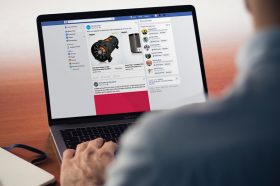Resources - Blog
How to Leverage Social Commerce on Amazon, Facebook, and Instagram

Stay on top of the latest e-commerce and marketplace trends.
Amazon and social media platforms had social commerce capabilities prior to the pandemic. However, the COVID-19 outbreak skyrocketed the growth of e-commerce, leading companies to improve and create new social commerce features. Subsequently, brands and sellers now have access to enhanced social media selling tools that will help them reach more consumers and increase discoverability.
Social media usage has also surged during the pandemic, as people are spending more time at home to reduce their exposure to the virus and abide by shelter-in-place orders. There were 150 million more social media users in 2020, reaching a total of 3.23 billion users worldwide per eMarketer data. Furthermore, 80.7% of internet users around the world are reported to use a social network at least once a month.
Consumers are shopping online and using social media more than ever before. Integrating the online shopping experience through a social media feature can drive growth for your business.
Learn how you can start leveraging social commerce on Amazon, Facebook, and Instagram.
Amazon
Amazon initially integrated social commerce on its platform in 2017 with the launch of Spark. The service enabled Prime users to shop for products (available on Amazon.com) from pictures in an Instagram-like feed. Spark was later scrapped by the retailer in 2019 due to its inability to communicate with customers in a meaningful way.
Amazon replaced Spark with Posts (beta) in 2019. The Posts feature is currently available and offers consumers a more organic content discovery experience. Brands and sellers can use the tool to publish a stream of lifestyle images and engaging descriptions that showcase their products in a shoppable feed.
Posts are visible to shoppers who are browsing categories that are relevant to a particular brand. Amazon sellers can drive brand and product awareness to a relevant and engaged shopper base through the retailer’s social commerce service.
Posts is free and accessible on mobile devices. The service is available in the United States to sellers, vendors, and agencies (representing vendors) who are enrolled in Amazon Brand Registry. You are not required to advertise on Amazon in order to qualify, but you must be selling on its marketplace. Amazon DSP users are also able to use Posts if they have an advertising console account in addition to their DSP account.
If you are eligible, follow the steps provided to begin using Posts:
- Visit the Amazon Posts webpage.
- Sign in with your Seller or Vendor Central credentials.
- Create a profile by verifying your brand name.
- Upload your brand’s logo.
- Start creating Posts instantly.
The company rolled out Facebook Shops in 2020 to meet the increasing need for small and medium-sized businesses (SMB) to sell their products online during the pandemic. While Facebook Shops was created for SMBs, large businesses can also benefit from the service.
Facebook Shops allows brands and sellers to create an online shop on Facebook. Businesses can customize the look and feel of their shop through colors and a cover image that represents their brand. Sellers can select the products they would like to showcase and enable the checkout feature to offer consumers the ability to make a purchase from their shop.
Brands and sellers are able to livestream video for new product launches, which is shoppable, from their online shop. Businesses also have the ability to interact with their customers directly to answer questions or address any concerns through Facebook Messenger. Consumers can discover Facebook Shops through business Facebook pages, stories, or ads.
Facebook Shops is free and accessible on desktop and mobile devices. The service is now available to businesses globally. To use Facebook Shops, you must be a Business Manager admin, own a Facebook Page and catalog as the Business Manager, and have Manage Page, as well as Manage Catalog permissions.
If you meet the requirements mentioned, follow the steps below to create your shop on Facebook:
- Visit the Create Your Shop webpage.
- In the “Choose A Way to Sell” section, click on “Create a Shop” and select the “Get Started” option.
- In the “Assets” section, click “Create a Shop.”
- From there, you can start setting up your shop. Click on your website and select “Get Started.”
- In the “Choose Your Business” section, click on the business page you would like to add your shop to.
- Enter your account name in the “Account Details” section and select the appropriate business account.
- In the “Where People Can View Your Shop” section, decide which platform you would like to create a shop for, Facebook or Instagram (you have the option to select both).
- In the “Catalog” section, choose from an existing catalog or create a new catalog.
- Review your shop details, as well as the Seller Performance and Accountability Policies. After you agree to the policies, click “Create Your Shop.”
Instagram’s latest social commerce feature is Instagram Shops, which rolled out at the same time as Facebook Shops. Since Instagram is a photo-centric app, it is a great platform for brands to showcase their products and convey their brand identity.
Instagram Shops allows brands and sellers to leverage their product assortment on a dedicated Instagram page while offering consumers the ability to purchase products directly from their digital storefront.
Brands and sellers can make the most out of their instagram shop by curating their product photos into themes, building out their product detail pages to include high-quality images and rich descriptions, including shoppable tags on their feed and stories, and livestreaming product launches that are shoppable.
Instagram Shops offers consumers an interactive shopping experience. Consumers can find a brand’s shop on the Instagram Shop page that populates when selecting the Shop tab on the Explore page. Sellers can also work with influencers or purchase ads to increase discoverability.
Instagram Shops is free and accessible on desktop and mobile devices. Consumers can only make in-app purchases from their mobile devices. Sellers can check if Instagram Shops is available in their region on the Instagram Help Center webpage.
To create a shop on Instagram, you must be a Business Manager admin, have a Instagram business account, own a Facebook Page and catalog as the Business Manager, and have Manage Page permissions for the Facebook Page that is associated with the Instagram business account, as well as Manage Catalog permissions.
To begin using Instagram Shops, follow the directions provided in the Facebook section but select Instagram as the shop option.
Final Thoughts
Although social commerce existed prior to the COVID-19 pandemic, the drastic rise in e-commerce and social media usage led companies to improve and build new social commerce capabilities. Brands and sellers who offer an online shopping experience through a social media tool will be able to reach a broader range of consumers.
Sellers can boost brand and product awareness by leveraging social commerce on Amazon, Facebook, and Instagram. If you have not started leveraging social commerce yet, we highly recommend reading about the services mentioned and signing up to be present where your customers are to drive growth for your business.
Learn what Feedvisor can do for your business.
When you partner with Feedvisor, you automatically receive access to our true, AI-driven technology and hands-on team of e-commerce experts. Contact one of our team members today to learn more about our end-to-end solution for brands and large sellers on Amazon, Walmart, and e-marketplaces.




